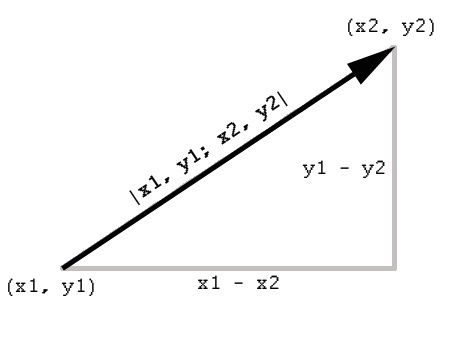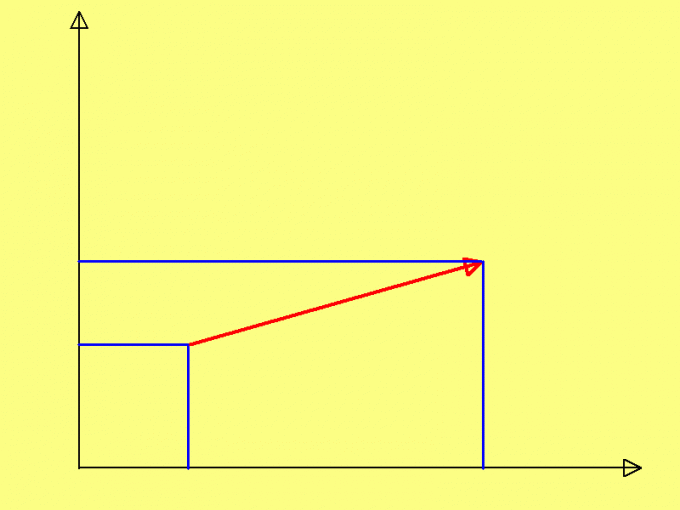Advice 1: How to find the modulus of the displacement vector
Instruction
During movement, the material body changes its position in space. Its trajectory can be a straight line or arbitrary, its length is the path of the body, but not the distance it has moved. These two values coincide only in the case of rectilinear motion.
So, let the body make some movement from point A (x0, y0) to point B (x, y). To find the modulus of the displacement vector, you need to calculate the length of the vector AB. Draw coordinate axes and put on them the known points of the initial and final position of the body A and B.
Draw a line from point A to point B, indicate the direction. Lower the projections of its ends onto the axes and plot on the graph parallel and equal segments passing through the points under consideration. You will see that a right-angled triangle with projection legs and a displacement hypotenuse has been designated in the figure.
Use the Pythagorean theorem to find the length of the hypotenuse. This method is widely used in vector algebra and is called the triangle rule. First, write down the lengths of the legs, they are equal to the differences between the corresponding abscissas and ordinates of points A and B:
ABx = x – x0 is the projection of the vector onto the Ox axis;
ABy = y – y0 is its projection onto the Oy axis.
Define displacement |AB|:
|AB| = √(ABx² + ABy²) = ((x - x0)² + (y - y0)²).
For three-dimensional space, add a third coordinate to the formula - the applicate z:
|AB| = √(ABx² + ABy² + ABz²) = ((x - x0)² + (y - y0)² + (z - z0)²).
The resulting formula can be applied to any trajectory and type of movement. In this case, the magnitude of the displacement has an important property. It is always less than or equal to the length of the path; in the general case, its line does not coincide with the curve of the trajectory. Projections are mathematical quantities that can be either greater or less than zero. However, this does not matter, since they participate in the calculation to an even degree.
A vector in geometry is a directed segment, which is characterized by an ordered pair of points in Euclidean space. The length of a vector is a number that is equal to the length of the segment that forms the vector.
Instruction
Let's find the square of the length of the vector. It is equal to the sum of the squares of its coordinates. That is, it is necessary to square each coordinate and add the results.
Find directly the length of the vector. It is equal to the square root of the sum of the coordinates of the vector. The newly obtained number will be the length of the original vector.
Related videos
Sources:
A vector in geometry is a directed segment or an ordered pair of points in Euclidean space. Ortom vector is the unit vector of a normed vector space or a vector whose norm (length) is equal to one.

You will need
- Geometry knowledge.
Instruction
First you need to calculate the length vector. As you know, the length (modulus) vector is equal to the square root of the sum of the squares of the coordinates. Let a vector with coordinates be given: a(3, 4). Then its length is |a| = (9 + 16)^1/2 or |a|=5.
To find ort vector a, it is necessary to divide each of its coordinates by its length. The result will be a vector, which is called the ort or unit vector. For vector a(3, 4) ort will be the vector a(3/5, 4/5). Vector a" will be single for vector a.
To check whether the ort was found correctly, you can do the following: find the length of the received ort, if it is equal to one, then everything is found correctly, if not, then an error has crept into the calculations. Let's check if the ort a is found correctly. Length vector a" is: a" = (9/25 + 16/25)^1/2 = (25/25)^1/2 = 1. So, the length vector a" is equal to one, so the unit vector is found correctly.
Related videos
note
The orth of the zero vector does not exist, since the length of the zero vector is zero.
Useful advice
In order to understand whether a vector is a unit, it is necessary to find its length. If it is equal to one, then the vector is unit.
A vector is a segment that has not only a length, but also a direction. Vectors play a big role in mathematics, but especially in physics, since physics very often deals with quantities that are conveniently represented as vectors. Therefore, in mathematical and physical calculations, it may be necessary to calculate the length of the vector given by the coordinates.

Instruction
In any coordinate system, a vector is defined through two points - the beginning and the end. For example, in Cartesian coordinates on a plane, a vector is denoted as (x1, y1; x2, y2). In space, respectively, each point will have three coordinates, and the vector will appear in the form (x1, y1, z1; x2, y2, z2). Of course, the vector can be defined both for four-dimensional and for any other space. It will be much harder to imagine, but mathematically, all the calculations associated with it will remain the same.
The length of a vector is also called its modulus. If A is a vector, then |A| is a number equal to its modulus. For example, any real number can be represented as a one-dimensional vector starting at the zero point. Let's say the number -2 will be the vector (0; -2). The module of such a vector will be equal to the square root of the square of the coordinate of its end, that is, √ ((-2) ^ 2) = 2.
In general, if A = (0, x), then |A| = √(x^2). From this, in particular, it follows that the modulus of a vector does not depend on its direction - the numbers 2 and -2 are equal in modulus.
Let's move on to Cartesian coordinates on the plane. And in this case, the easiest way to calculate the length of the vector is if its origin coincides with the origin. The square root will need to be taken from the sum of the squares of the coordinates of the end of the vector. |0, 0; x, y| = √(x^2 + y^2). For example, if we have a vector A = (0, 0; 3, 4), then its module |A| = √(3^2 + 4^2) = 5.
In fact, you calculate the modulus using the Pythagorean formula for the hypotenuse of a right triangle. The coordinate segments defining the vector play the role of the legs, and the vector serves as the hypotenuse, the square of which, as is known, is equal to the sum of their squares.
When the origin of the vector is not at the origin of the coordinates, the calculation of the modulus becomes a little more laborious. It will be necessary to square not the coordinates of the end of the vector, but the differences between the end coordinate and the corresponding start coordinate. It is easy to see that if the origin coordinate is zero, then the formula turns into the previous one. You use the Pythagorean theorem in the same way here - the coordinate differences become the lengths of the legs.
If A = (x1, y1; x2, y2), then |A| = √((x2 - x1)^2 + (y2-y1)^2). Suppose we are given a vector A = (1, 2; 4, 6). Then its modulus is |A| = √((4 - 1)^2 + (6 - 2)^2) = 5. If you build this vector on the coordinate plane and compare it with the previous one, you can easily see that they are equal to each other, which becomes obvious when calculating their length.
This formula is universal, and it is easy to generalize to the case when the vector is located not on the plane, but in space, or even has more than three coordinates. Its length will still be equal to the square root of the sum of the squared differences between the end and start coordinates.
Sources:
- Applied Mathematics - Collection of Formulas
To define a vector in space, a coordinate system is used. In this case, it must be taken into account that in addition to the length (module), it is also characterized by direction. Length vector can be simply measured or found using formulas.

You will need
- - ruler;
- - protractor.
Instruction
In the simplest case, in order to find the length vector, use a ruler to measure the length of the segment, which is the vector.
A vector in space is given by the coordinates of its start and end points. Designate the coordinates of the start point (x1;y1;z1), and the end point (x2;y2;z2). To find the length vector, do the following:- determine the coordinates vector. To do this, subtract the corresponding coordinates of the end point x=x2-x1, y=y2-y1, z=z2-z1 from the coordinates of the start point. Get a vector with coordinates (x; y; z); - find the sum of the squares of all coordinates vector x² + y² + z². Take the square root of the result. This will be the length of the considered vector.
If the coordinates vector given immediately, the task is simplified. If the vector is located not in space, but on a plane, then one of the coordinates is simply removed; typically, this is the z-coordinate. Then the length is found by substituting only two coordinates into the formula. If the vector is parallel to one of the axes, then its length is equal to its coordinate along the axis to which it is parallel (if the coordinate is negative, take its modulus).
Sometimes to determine vector use its projection on the axis, and the value of the angle to this axis. For example, projection vector on the OX axis is x0 and it is at an angle α to it. Find the length vector, multiplying its projection on the axis by the cosine of the angle at which it is located d=x0 cos(α).
If the vector is the sum of two vectors, with known lengths and the angle between them, which is measured with a goniometer or protractor. Find the sum of the squares of the lengths of these vectors and subtract from the resulting value twice the product of their lengths, multiplied by the cosine of the angle between them. This will be the length of the desired vector. If the coordinates of the vectors are known, the sum of which is found, add their corresponding coordinates, obtaining the coordinates vector, which is their sum, and then find its length from the coordinates.
In mathematics and physics, the "modulus" is usually called the absolute value of a quantity, not taking into account its sign. In relation to a vector, this means that its direction should be ignored, considering it to be an ordinary straight line segment. In this case, the problem of finding the module is reduced to calculating the length of such a segment, given by the coordinates of the original vector.



